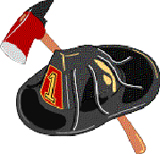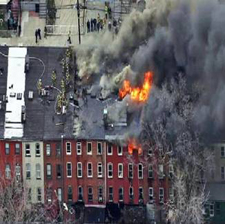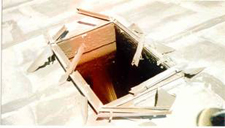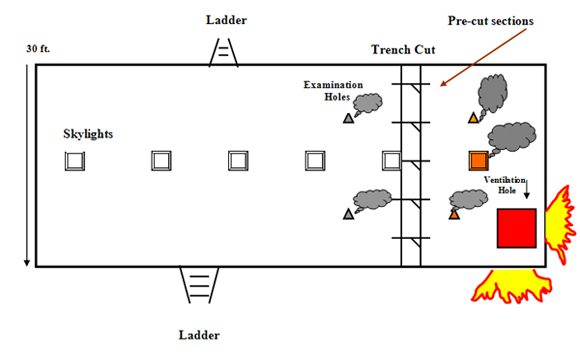Trench Cutting Operations:

Fires that extend into the cockloft of Taxpayers, Row Frames, Row Bricks and H-type multiple dwellings are notorious for their rapid spread through-out the space. When a fire involves the top floor and/or cockloft of a building of this type, chief officers must be prepared to assign resources to the building’s roof in an aggressive attempt to halt the horizontal fire extension. Members assigned to this task must be well disciplined and experienced in roof operations. In buildings that have a common cockloft with attached structures, or large structures that have a large undivided cockloft, members can utilize a tactic referred to as “trenching the roof.”  Trench cutting a roof in a attempt to stop the horizontal fire spread throughout the space is a resource intensive operation that should only be attempted when there are enough members and tools to handle the task. Additionally, any attempt at this operation must also be realistic. It is critical to identify how much of the roof you will need to cut or trench, and if it can be accomplished with the resources that are available. If the trenching operation seems impractical, it may be best to continue with “enlarging the primary ventilation hole over the main fire area” with the resources that are available. If the answer is “yes we can trench”; then be prepared for the following.
Trench cutting a roof in a attempt to stop the horizontal fire spread throughout the space is a resource intensive operation that should only be attempted when there are enough members and tools to handle the task. Additionally, any attempt at this operation must also be realistic. It is critical to identify how much of the roof you will need to cut or trench, and if it can be accomplished with the resources that are available. If the trenching operation seems impractical, it may be best to continue with “enlarging the primary ventilation hole over the main fire area” with the resources that are available. If the answer is “yes we can trench”; then be prepared for the following.
What follows is a list of operational tips for a trench cutting operation.
Roof Operations, Primary Ventilation Hole:
- Ladder the roof.
- Ensure that there are at least two means off the roof.
- Sound/check the roof before entering.
- Be watchful for cell phone towers, guide and antenna wires.
- Assign a guide firefighter with the saw firefighter.
- Plan the cut and inform members.
- Attempt to work with the wind at your back.
- COMMUNICATE and COORDINATE ALL roof operations with INTERIOR members!
- Cut, and pull the primary ventilation hole.
- Utilize the 7-9-8 cut.
- Push down the ceiling over the main fire area.
- Continue to enlarge the hole in an attempt to create a thermal updraft and slow the fire’s horizontal movement.
- Communicate the completion of the opening with Command and Interior forces.
- Drop inspection holes on either side of the primary hole to determine the fires horizontal movement.
- Open up the return walls within the scuttle openings of attached structures to determine fire spread within the cockloft.

- When fire is threatening to spread throughout the cockloft, prepare for trenching operations.
Roof Operations, Trench Cut:
- Ensure that the primary ventilation hole over the main body of fire has been established BEFORE cutting the trench.
- Cut, pull, and push the primary ventilation hole BEFORE pulling the trench or you will draw the main body of fire toward your trench. Remember, trenching is a defensive operation!
- Place the trench at least 25 feet from the primary ventilation hole. This will allow time to cut and pull the trench.
- Make the trench three to four feet wide from the front to rear walls of the building.
- When possible, utilize building features when cutting the trench. Examples could include roof skylights, scuttles, bulkheads or throat areas with an H-type designed building, etc.
- Precut the trench every four feet along its length to assist with the speed when pulling.
- Pull the trench (always pull to the safe side of your trench).
- If it appears that fire involves ONLY the cockloft of the adjoining building/floor area, do NOT push down the ceiling.
- If it appears that fire ALSO involves the top floor of the adjoining building/floor area, coordinate with interior forces and push down the ceiling after pulling the trench.
- Assign a significant group of firefighters with hooks and hose lines to the buildings top floor.
- Provide multiple means of egress from this area as well.
- Again, COMMUNICATION and CONTROL with interior members is critical!
- Communicate the completion of the “trench” with Command and Interior forces.
- Drop/cut additional inspection holes to monitor fire travel.
- Constantly stay alert to your means of getting off the roof.
* In the diagram below, we are illustrating a simulated primary-ventilation hole and trench cutting operation on the roof of a row of stores or dwellings (you pick). The operation reflects how the cutting could/should look.

Stay Safe!
Mike Terpak
Deputy Chief-Jersey City
